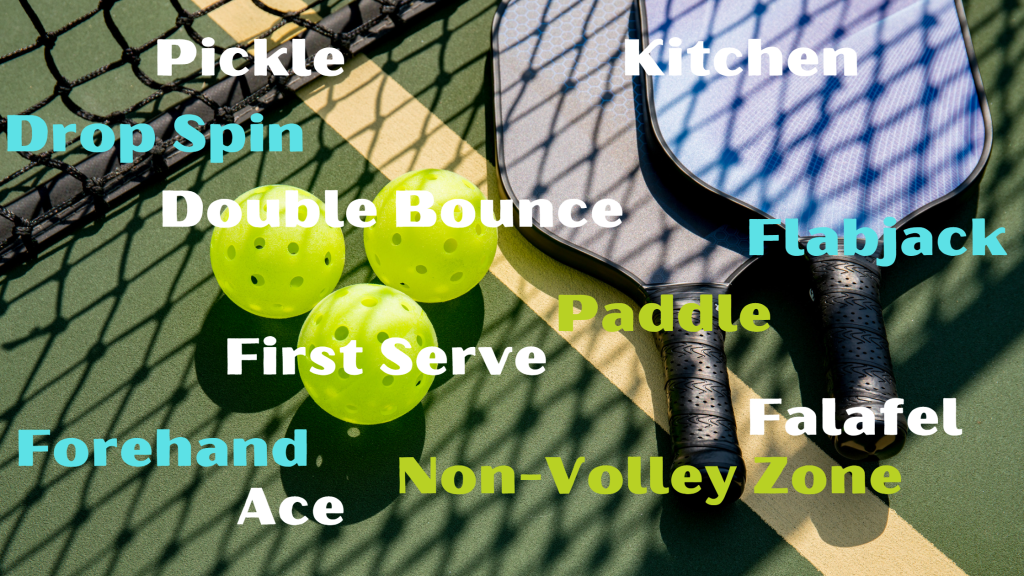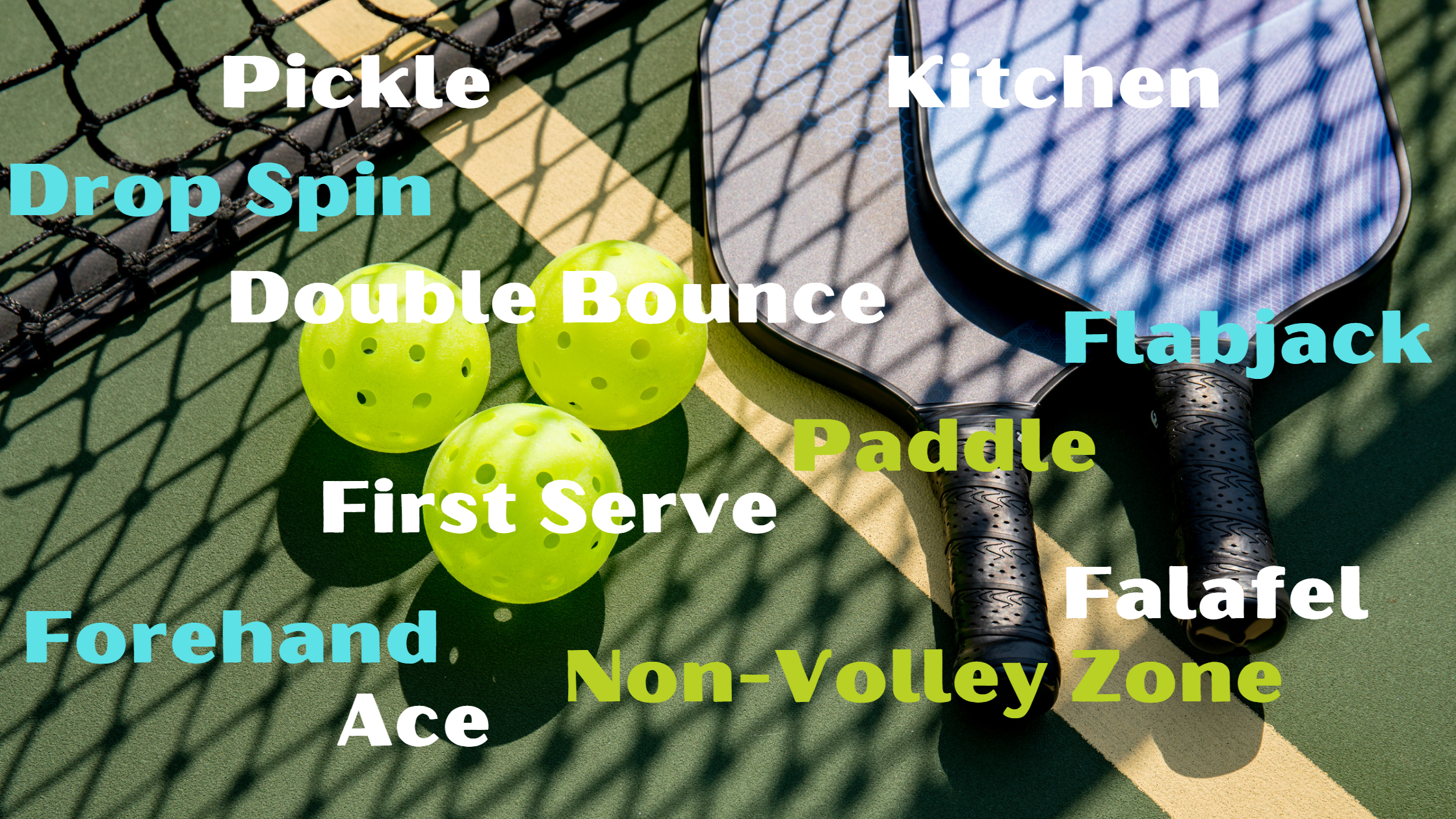Pickleball is a new sport that is just becoming popular but has lots of promise. It is one of the fastest-developing sports activities in the United States. It combines badminton, tennis, and table tennis and is perfect for all ages and skill levels. Whether you are a seasoned athlete or just beginning to explore the world of pickleball, it is important to familiarize yourself with the terms and definitions of the game. This blog will explore some of the most common pickleball terms and definitions to help you join the pickleball conversation.

Are you ready to join in on the newest trend in sports? Pickleball is taking the nation by storm, and it’s time you jump on the bandwagon. But before you do, you should know some of the funny, hilarious and unique pickleball terms that will have you laughing and playing in no time.
Discover the Pickleball Lingo: Unravel the Mystery of Pickleball Terms
Ace
A serve that is not sent back by the adversary. A point is earned from the serve without being returned
Approach Shot
The ball is struck while moving in a forward direction towards the pickleball net.This is called shot
Backcourt
The region close to the starting line, about a few feet within the court from the beginning
Backspin
Also referred to as “Slice” or “Chop”, it imparts spin on the ball by hitting it with higher to lower movement, resulting in the ball spinning in the opposite direction of its trajectory
Backswing
The action of taking the pickleball paddle from the prepared stance before proceeding with a forward swing involves swinging it backwards.
Backhand
Hit where the player smacks the ball on the opposite side from their stronger backhand
Baseline
The rear boundary of the pickleball court is marked by a line that stretches 22 feet from either side of the net.
Bounce It
Instructions shouted to partner to not hit the ball and let it drop (since you believe it will go out of bounds).
Carry
Striking the ball in a manner that it does not ricochet from the pickleball racket but rather remains on the surface of the paddle during its onward movement.
Cross-court
The court area is situated diagonally opposite your side court.
Centerline
A straight boundary that stretches across the No-Serve Area to the Backline, separating the service area into two equal parts
Champion Shot
A pickleball stroke that ricochets twice in the No-Volley Area
Chop
Cut in an upwards direction to apply backspin to the pickleball.
Dead Ball
The point is over when a ball is declared dead after a fault.
Dillball
A ball that is still in play and has struck the ground at least once
Dink Shot
A gentle lob that ascends above the net and lands in the opposite non-volley region
To learn more about the game of pickleball, one must visit the “What is Dink in Pickleball“.
Double Bounce
A ball that rebounds more than once, on a single side, before being sent back. After the serve, each team must hit the ball at least once off the ground before volleying it (hitting it in mid-air)
Double Hit
A player may strike the pickleball ball twice consecutively before sending it back over the net, or it may involve both players on a side. A double hit is possible
Drop Shot
A groundstroke shot that does not reach the opponent’s spot
Down the Line
A pickleball shot that glides close and alongside the boundary line
Drive
A forehand stroke struck squarely and low, into the opposing backcourt
Drop Shot Volley
A volley strike intended to dramatically decrease the velocity of the ball and send it back close to the net, near an adversary located at or near the baseline
Drop Spin
A pickleball shot that is hit with the intention to cause a sudden drop as soon as it passes the net is an advanced technique.
Are you feeling overwhelmed by all the pickleball terms out there? Don’t worry, we’ve got you covered! Let’s take a closer look at some more common pickleball terms and their meanings so you can keep up with the game like a pro.
Face
The extensive face of both sides of the pickleball paddle used to hit the ball
Falafel
It is a weak hit or a “dead paddle,” is when one strikes the pickleball ball with insufficient force
Fault
A Fault is any behaviour that causes play to be halted due to a breach of the regulations
First Serve
To start a fresh game, only one individual from the initial serving side is allowed to serve. Once a fault has been committed, the service shifts over to the opposing team.
Flabjack
A pickleball stroke in the air must be allowed to drop to the ground once before it can be struck during either of the initial two strokes of every point (the return of service or the return of serve return). After the third shot, no bounce is required and a direct hit can be made.
Flat Face
Maintaining the paddle’s hitting face aligned with the net.
Foot Fault
When serving in pickleball, the player must have one foot behind the back line of the court before hitting the ball; neither foot may touch this baseline or any part of the court until after striking. Violation of this rule will result in a serving foot fault. Additionally, if a player volleys a ball while standing inside the Non-Volley Zone (NVZ) or stepping on its line, then that player commits a Non-Volley Zone foot fault.
Follow Through
On the swing, the continuing onward movement (after the backswing) in the direction of where the pickleball should go.
Forehand
A right-handed player would begin their forehand stroke with their right hand behind them, then proceed to pull the paddle across their body..
Let’s keep on rocking with more pickleball terms! Get the latest jargon and lingo so you can impress your court mates and dominate the court. Get ready to learn new skills and up your game. Pickleball has never been more fun!
Grip
The way you clasp the paddle handle with your hand (e.g. continental grip) or the cloth that is wound around the paddle handle to protect it and provide padding (such as grip tape)
Ground Stroke
Striking the ball on the rebound instead of volleying it in midair.
Half Volley
A groundstroke hit is where the paddle interacts with the ball right after it rebounds from the court and before it reaches its maximum altitude.
Head
One of the two parts of the pickleball paddle which includes the paddle face (hitting surface and paddle edge)
Hinder
An element that interrupts play or something that interferes with the play is called a hinder
Juniors
Players under the age of 16 but above 7. In 2016 USAPA Juniors was established to support these young players.
Kitchen
The non-Volley zone is also called as the kitchen in pickleball.
Line calls
If the ball touches the ground on or below the lines, it is considered in (except for the Non-Volley Line), otherwise, it is out
Lob
The opposing side is forced back to the baseline by a shot that returns the ball high and deep.
Let’s keep pushing forward with even more Pickleball terms! Master all the lingo for a better understanding of the game and to become an ace on the court. Get to know all the common terms used in Pickleball to communicate and play like a pro.
Midcourt
The midcourt is in the middle of the court between the baseline and the non-volley zone
Non-Volley Zone
The section of court next to the net is referred to as the Non-Volley Zone. While standing in the non-volley zone, a player can’t volley a ball. All lines surrounding the zone are included.
Overhead Shot
Overhead Shot is a shot where the paddle starts high above your head and drives downward, like a tennis serve
Overhead Slam
Overhead Slam is a shot that is hit in a downward motion. It’s usually done on the return of a high-bounce shot
OPA!
After the 3rd shot has been hit, and shouted out, open volleying has begun
Open Face
It means the position in which you can hold a pickleball paddle that is tilted slightly upward
Paddle
The paddle is similar to a racket in tennis or racquetball. It’s possible to make a pickleball paddle out of wood, Composite or Graphite.
Passing Shot
A passing shot is a volley or groundstroke shot that is aimed at a distance from the player and is meant to prevent a return of the ball.
Permanent Object
Any object around the court that could interfere with the flight of the ball is a permanent object. Walls, fences, fixtures, lights, net posts, bleachers or spectator seating, the referee, line judges, spectators themselves, and all other objects around and above the court are permanent objects.
Pickle
The server shout out a warning to everyone on the court that they were about to serve
You’re getting more and more impressive in the world of pickleball! To take it to the next level, here are a few more interesting pickleball terms you should know: second serve, rally, singles, and volley. Impress your friends and opponents with your pickleball savvy!
Second Serve
The condition when a serving team begins the game or loses the first serve is called the second serve.
Overhead Slam / Smash
An overhead slam is a hard, overhand shot that results from an opponent’s high bounce
Singles
Two people playing a game with one on each side.
Volley
Hitting the ball in the air, during a rally, before the ball has a chance to bounce onto the court.
From the basics like serving and scoring to more advanced terms like dinking and moonballing, we’ve got you covered with our comprehensive list of pickleball terms. Get ready to sharpen your skills and take your game to the next level!
Must read the article Pickleball Rules for more understanding of the game.
